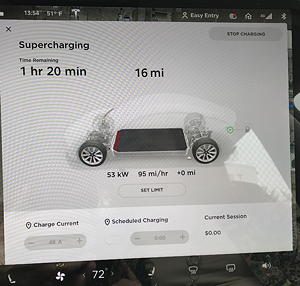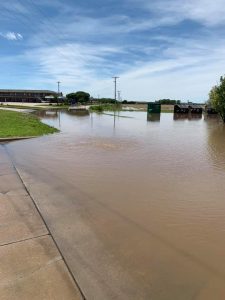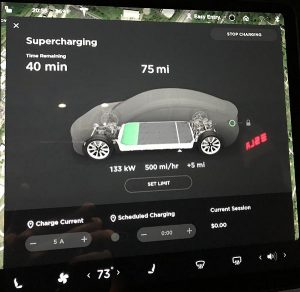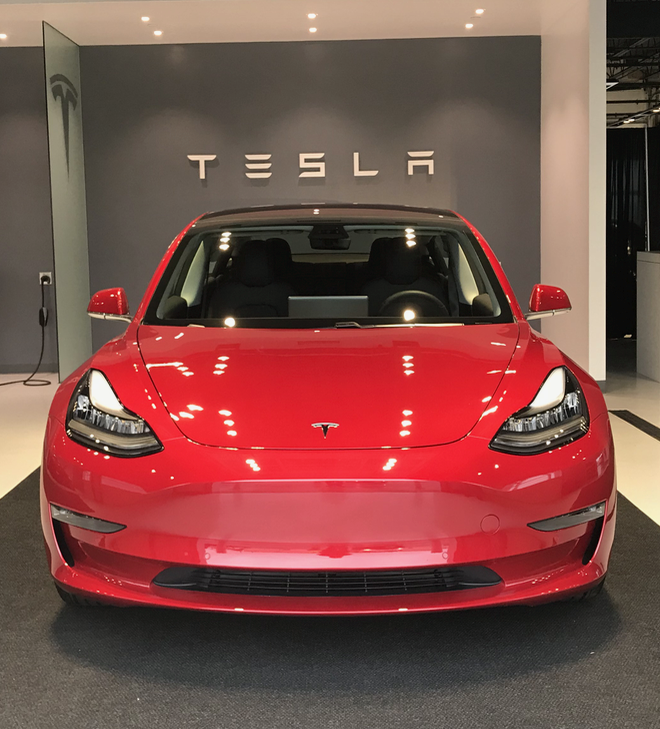There is a way that seems right to a person,
but its end is the way that leads to death.
Proverbs 14:12A person plans his course,
but the Lord directs his steps.
Proverbs 16:9
Range Anxiety
“Range anxiety” can be defined as the concern, worry, or fear that your vehicle will not be able to get to your desired destination. It is not, as my brother first intuited, a fear of wide open spaces experienced in the plains (as in, “Home on the Range”)
For most people, driving internal combustion engine (ICE as we EV owners call them) cars, it’s something rarely experienced except in the remotest areas. The reality is that you can’t go more than a few miles without finding a place where you can fill up your tank with dinosaur juice.
It’s a more serious concern if you are in an airplane or on a boat in the middle of the ocean. And it’s a very real concern in an all-electric car.
Tour de Tesla
Taking a long distance trip in a Tesla is different from driving an ICE car. A road trip in a Tesla is punctuated by stops to recharge the battery. First, you decide how far you want to go in a day, then you look for hotels with “destination chargers”. A handful of hotels around the country have installed Tesla chargers that allow you to wake up to a fully charged car, which makes a significant difference in a long road trip.
Next, you tell the car to calculate a route to your stopping place. Tesla has built an extensive network of Supercharger stations, such that it is possible to get most places in the United States or Europe (no, you can’t drive from the United States to Europe). The car is knows where the Superchargers are, and will (by default) tell you which station(s) to stop at to get from where you are to where you want to be.
Warm Up Lap
On our first road trip, I charged the car to 100% capacity and set our destination. The car told us to stop at the supercharger in Colby, KS and off we went. As we got closer to the stop (but not that close) I had my first encounter with range anxiety. The car’s estimated range is an approximation, based on a lot of factors, so you can’t take an estimated range of 50 miles and assume that you will drive exactly 50 more miles. Watching the remaining range continue to decrease, and seeing how many more miles to the stop, I was starting to second guess the car. When we arrived at the Supercharger with 16 miles of range remaining, I decided that the car was more aggressive than I; we would rather stop more frequently and not worry than get a panic attack before every stop.

Green Flag
On our next road trip, we knew that it was possible to get to Colby, but we weren’t having it, so when the car routed us to Goodland, KS I was pleased. I thought perhaps, in addition to the software updates that had given us nearly 10% more range, perhaps the navigation had been tuned to live a little further away from the edge, for old fogeys like us.
We stopped at Goodland, enjoyed lunch at the Steak-N-Shake next to the charger, and left with another full charge. I was surprised, however to see that the car wanted us to stop in Hays, KS, arriving with close to 50% charge. While cautious, I thought that was ridiculous so we did some quick math and determined that we could get to the charger in Salina comfortably.
It would be really nice if the navigation software allowed some customer tweaking, like specifying a minimum level of charge before stopping, or explicitly adding charging stops (or even adding additional stops, like finding food for a vegetarian passenger). But it doesn’t so I simply drove through Hays, on our way towards Kansas City, without stopping.
Yellow Flag
The navigation system adapted to my intransigence by continually suggesting that I take each exit before it passed, so I could turn around and charge up. Finally, frustrated that the car wouldn’t figure out that I could make it to Salina, I changed the navigation to go directly to the Salina charger and on we went.
As we approached Salina, my wife noticed something different about the Supercharger icon on the map. Looking more closely we realized that it had the universal “no” icon (circle with a diagonal line) through it. Panic began to set in. I quickly called Tesla, because if the station was closed I was going to be in a world of hurt. The very nice man on the other end of the phone assured me that the station wasn’t closed, but it was “degraded”. He said one of the pillars was taken out of service by the electric company, but the other two were fine. Relieved, we continued on our way.
I have to say that I despise the Salina Supercharger. It has the worst amenities of any charger we have stopped at to date. It’s at the end of a barely paved road, in the parking lot of a Holiday Inn Express. There are no other reasonably nearby amenities (there’s an IHOP about 1/4 mile back up the road, but you wouldn’t want to walk that in the dark… or at all, if you are me). Unfortunately, its location and the spacing between superchargers makes it an ideal stop when driving between Denver and Kansas City. My dislike of this stop was not eased by what happened next.
As we exited the freeway and made the turn onto this poor excuse of a road, we were greeted by a “road closed” sign and several inches of water across the road. The panic started knocking at the door again.

I pulled into the truck stop on this side of the water and called Tesla again, looking for suggestions. I was really hoping that they would tell me that they would be right there with a tank of electricity to get me on my way; unfortunately the fellow who answered the phone this time was not as helpful and transferred me to the general support line. I’d endured that particular pain before, and didn’t have the hour to wait on hold so we hung up and called the hotel. They said yes, they were open and that “the water isn’t that deep, if you stay to the center of the road”. I started to brave it, but about a foot in, I decided that there is a decided difference between wisdom and foolishness. Electric car + water did not add up to a winning outcome. So I backed out and regrouped.
Looking at the map, there appeared to be another way to get to the hotel, so I started out. This time I turned off the main road onto an under-improved dirt road. Driving carefully to avoid the potholes (all I needed was to blow a tire to make this adventure complete), I came to where I was to turn towards the hotel. I made the turn and found myself at a rickety little bridge with what appeared to be a wet sand road ahead of me. I decided that pursuing that path wouldn’t end well either, before we saw the sign that said “Road closed when wet”.
Time for one last call to Tesla. I needed options. I had 53 miles of range left; not enough to go back to Hays or the 100+ miles on to Topeka. All they could offer me was a campground with a Nema 14-50 plug, or a nearby Nissan dealer with a J1772 plug.
Mechanic’s Tools
A note about charging. The Tesla Supercharger is one of the major reasons for Tesla’s popularity. When it comes to electric cars, range is king; the farther you can go without charging, the better. Next in importance is how fast you can re-charge and get back on the road. Tesla owners talk about charging in terms of “miles (of range) per hour”. While many factors affect charging rate, at a Supercharger, I can charge at up to 500 miles/hour.

A destination charger will charge between 25-40 miles/hour (which is fine for overnight charging). As noted, a 120v outlet will charge at 5 miles/hour. Were it not for the Supercharger, long-range electric car travel would simply not be viable. A 30-40 minute stop at a Supercharger is a nice respite from driving and long enough to get a good charge before moving on down the road.
My Tesla came with a nice little zipper bag that includes a 20 foot charging cord and adapters for either 120v (wall plug) use or 240v Nema 14-50 outlets. Since my daily commute is trivial, I’ve been content to use the 120v connector. This comes with a loss of efficiency and only charges at a rate of 5 miles of range per hour, but meets my needs. Before leaving on this trip, I debated unplugging the cord and putting it back in the bag, but we had pre-booked destination charger hotels and I just couldn’t see a need to plug in anywhere, so I made the decision to leave it plugged in at home. Therefore, stopping at the campground was not an option. Besides, as it turns out, the campground is next to the hotel that we couldn’t get to!
Pit Stop
We went on to the Nissan dealer, arriving around 6pm. Fortunately, the zipper bag with the J1772 adapter was still in the car, so I was able to plug in and begin charging. We then took advantage of their restrooms and waiting room, and we waited. And waited. And waited.
By the time we got to the dealer, I was down to about 25 miles of range. I needed to go 100 miles or so to Topeka, and I wanted some buffer. While I was certainly grateful for the charger, happy that it was free, and appreciated the hospitality of the dealership (until they closed at 8), charging at 24 miles/hour was one of the most painful travel experiences of my life. We charged for four hours before getting back on the road at 10 pm.
Remember what I said about range having a number of factors? As I set my navigation to the Topeka Supercharger, I was cautioned to keep my speed below 70 to reach my destination. Not wanting to be stranded in the middle of Kansas in the middle of the night, I set my cruise control to 65 and off we went.
My car has a graph showing real-time battery consumption and an estimated range, based on that consumption. My wife was glued to the screen, as each hill we climbed ate into the range, and the downhills added to it. Over time, it appeared that we were maintaining a constant 20 miles or so of range buffer. It was one of the most tense 90 minutes in recent memory, but we were never so happy as to pull into the Topeka Supercharger. By the time we walked over to the Quality Inn to use their restrooms, and walked back we had more than enough charge to make it to our hotel in Kansas City.
Checkered Flag
I really hesitate to add this part. While there are many hotels with Tesla destination chargers, there is only one in Kansas City. When there are more Teslas than there are chargers, someone has to do without (this happened to me one night in Franklin, TN). However, the staff at the Homewood Suites in Kansas City are so kind and eager to support Tesla owners, that I feel I owe them a mention (even it it means you take my charging spot on my next trip!). This hotel has two Tesla chargers and one J1772 charger (for the rest of you).
When we got back on the road after our “time out” at the Nissan dealer, my wife called the hotel to let them know that we would be arriving late, and in need of a charge. The very nice person at the desk walked out to the parking lot, determined that there was still a Tesla spot left, and put cones in the spot to save it for us. We were so grateful when we arrived at 1:30 AM to know that we could plug the car in and go to bed, and wake up to a full charge.
On the return trip, we pulled into the hotel much earlier(!). Only a handful of cars were in the hotel lot; perhaps 10 total. Yet as we drove around to the EV spots, I discovered I had been “ICEd out” (when ICE cars park in EV spots). The front desk staff was very upset by this (unfortunately, they didn’t have any way to match vehicles to guests). They promised to try to figure out who was there and make them move. In the meantime, they assured me that I was safe to park in the adjacent handicap spot, which was well within reach of the charging cables. Our room was directly above where the car was parked, so an hour later or so, when one of the offending cars moved, I was able to see and move out of the handicap space.
When we checked out, they were very interested in suggestions of how to prevent this situation in the future. We shared with them that the hotel in Franklin had a sign that said “Tesla Parking Only; All others will be Towed” and they liked the idea. I have to say that this level of support and accommodation makes this hotel a “must stop” for me. I encourage you to stay there as well (but not when I’m passing through!).
Application
If I haven’t tortured the racing analogy too much, at the end of every race the team reviews the performance of the car, the driver, and the crew. Each person looks for how they can improve the area where they are responsible to make the next race better.
Observation without application is just entertainment. Rather than waste a perfectly good lesson, I will leave you with three.
Lesson One: Trust Someone Smarter Than You
Trust in the Lord with all your heart,
and do not rely on your own understanding.
Acknowledge him in all your ways,
and he will make your paths straight.
Proverbs 3:5-6
We’ve been living with smart phones for some time now, and have some amusing family stories that all lead the the same conclusion: Trust Siri. While it’s possible she is wrong, it’s more likely that you are so just go where she tells you.
Similarly, my car knows things that I don’t. I’d like it better if it would share more with me, and allow me to be engaged in the decision process, but the bottom line is, if the car tells you to stop in Hays and charge, you need to stop in Hays whether you think you need to charge or not. You don’t know what’s down the road (but the car might).
Case in point: On the return trip, the car was telling us we would arrive in Kansas City with about 11% range (about 30 miles) remaining. While tight, it was manageable, except for one thing: you get less range at 80mph than you do at 65. As we continued down the road, our reserve dropped into the single digits and I was anticipating a repeat performance of the outbound trip.
As we entered Columbia, I decided that a quick top-off would be in everyone’s best interest. After about 15 minutes, we were back on the road, but soon we saw a sign on the road saying there was a vehicle fire just past Exit 121. About that time, the navigation system began telling me to exit at Exit 121. We inched along in bumper-to-bumper traffic, squeezing over to let an emergency vehicle drive up the middle of the freeway, until we finally got to the exit. Surprisingly, very few people were taking the opportunity to leave the traffic jam. The car faithfully navigated us down back streets I didn’t even know existed until we were past the problem and were able to resume our freeway driving.
More generally in life, God knows more than you do; you aren’t as smart as you think you are. You will do much better if you listen to the one who created you and who sustains all things. Unfortunately, we don’t come with navigation systems that can route us around the unforeseen problems of our lives, but God has revealed his wisdom for living in the Bible. While we may think we have a plan, God has the final word in how things turn out.
Lesson Two: Worry Won’t Make the Car Charge Faster
Do not be anxious about anything. Instead, in every situation, through prayer and petition with thanksgiving, tell your requests to God. And the peace of God that surpasses all understanding will guard your hearts and minds in Christ Jesus.
Philippians 4:6-7
I have defined stress as “emotional energy expended on something over which you have no control”. Anxiety is stress out of control, and it is a huge issue in American society today; billions of dollars are spent on alcohol, prescription and other drugs as a way to numb the pain.
As a result of various life experiences, and a deep and abiding faith in the goodness of God, I’m not generally prone to anxiety. However, as the situation unfolded our general range anxiety gave way to full-blown anxiety. I had a sinking feeling in the pit of my stomach that something bad was going to happen and I couldn’t stop it. Through all the phone calls trying to work out a solution I held the anxiety at bay, but as we sat waiting for our car to charge, 24 painful miles at a time, I started becoming physically ill. Things would not be better until we were back on the road. Despite the fact that leaving before the car was sufficiently charged would not end well, it took all of my mental resolve to just sit and wait.
Surely, all of us have faced situations outside of our control: physical illness, financial distress, wayward children, the list goes on. Some try to adopt the advice of Bobby McFerrin or Douglas Adams, but in the end it doesn’t work.
The best cure to anxiety is given in the Bible. When there is something you can do about the situation, you do it. When there is not, your worry won’t have a (positive) impact on the situation.
Lesson Three: Sometimes Bad Things Happen
My brothers and sisters, consider it nothing but joy when you fall into all sorts of trials, because you know that the testing of your faith produces endurance. And let endurance have its perfect effect, so that you will be perfect and complete, not deficient in anything.
James 1:2-4
Heeding my own advice, I consciously tried to release my anxiety. I wondered what purpose God might have for me to be in this place at this time. I looked around for someone who I might possibly be a blessing to, but the dealership was deserted. When the very nice manager told us we had to leave, I was left in my car with just my wife and daughter. And I found no purpose, no redeeming quality, no hand of God. Just the incessant waiting.
Truth be told, in the “testing of my faith” I had come up lacking. I was mostly certainly “deficient” in patience, kindness, gentleness. Caught up in my own emotions, I was brusk and thoughtless with my family. For the rest of our trip, I continued to process this situation. I apologized for my harshness and we continued to try to figure out how to live broken together.
We search for meaning in our difficult circumstances, because if we can ascribe some greater good to our misery, if it has significance, then somehow enduring it seems more noble. But sometimes (and I think this might have been one of those times) we just have to endure hardship to give us practice enduring. Like lifting weights strengthens our muscles, facing trials strengthens (and proves the quality of) our faith.
I had a pastor’s wife say that she prayed for patience and God gave her sons. There is nothing glamorous about the process of acquiring patience, nothing delightful about the opportunities to demonstrate it. Yet patience is a fruit of the Spirit, and an attribute of the Most High God. Certainly, it is worth the cost.
Epilogue
Traveling with adult children is … interesting. My daughter is very much like me, and I enjoy talking with her immensely. We can process things together in a way that my wife (who is nothing like me) finds difficult. On the other hand, my daughter is very much like me, so she is quite skilled at seeing my faults and not shy about “sharing” them. Having her with us was an fitting backdrop against which this drama could unfold.
She said that she felt no stress during the whole ordeal. We were safe at all times, we had food (well, junk car snacks), we had electricity, and in the end we got to where we wanted to go. Since she had no responsibility, control, or ability to affect the outcome of our trip, she was able to just sit back and let things unfold.
How about you?



